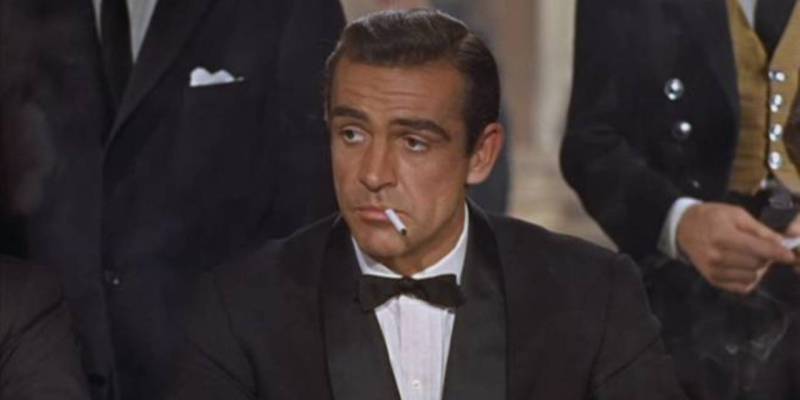James Bond indulges in vodka martinis, cigarettes, and high-stakes poker, and he does it all with suave sophistication. He famously wields two pistols: a small Walther PPK causing men to scream as they die and a much larger tool inducing women into moaning wrecks of ecstasy. Basically, Bond isn’t suitable for kids, despite looking killer in a tux. But as a kid in my single digits, I was still entranced.
Bond’s lack of morals was never a turn-off for me. As a kid, I was obsessed with James Bond to where I would forgo Spike TV’s annual Bond-athon and do my own twice yearly. I quoted hammy Bond one-liners embedded with sexual innuendo I didn’t understand. My fandom even expanded beyond the movies. I bought (read: my mother bought) the James Bond encyclopedia as well as film soundtracks containing the Bond theme songs. A local FYE’s self-avowed Bond aficionado even gave me book recommendations.
My mother had concerns. While she overall liked the movies and was amused by my adoration of 007, she also knew that I had a tendency to be overly obsessive about the films I enjoy. To provide context to Bond’s exploits on the battlefield and in the bed sheets, my doting mother attempted to inject some morals into the proceedings. She once even asked me: “How could you love such a misogynistic womanizer?” My sincere response to this cutting inquiry was always along the lines of: “He murders people and sleeps with hot women for queen and country!” How innocent.

This love for James Bond sadly hasn’t survived the passage of time. When I reached adulthood, the James Bond franchise had transformed from an adorably cheesy B-movie franchise filled with bad sex puns. It was now the Daniel Craig era: a more grounded and realistic series that was hit or miss. While Skyfall and Casino Royale are great modernized 007 films, Quantum of Solace remains a dull dud and Spectre is possibly the worst Bond movie of all time for attempting to inject a superhero-style origin story into the proceedings. As a result of modern Bond’s inconsistent quality, I’ve become attached to other movie franchises clearly influenced by the series’s core adventure serial traits.
The Marvel Cinematic Universe is the most noteworthy franchise that successfully modernized the James Bond formula. Despite installments starring different protagonists like Iron Man, Captain America, and Captain Marvel, the MCU has an episodic quality to it. Particularly, MCU villains like Alexander Pierce and Ultron are one-offs similar to baddies in Bond’s rogues’ gallery like Goldfinger or Xenia Onatopp.
James Bond and the MCU do have exceptions to the one-and-done rule. Blofeld, 007’s archnemesis and head of the evil spy agency SPECTRE, reappears in several Bond sequels similar to how Loki reemerges in various movies across the MCU. More importantly, the protagonists and other supporting characters regularly stay the same — though the Bond franchise will replace the actors far more regularly. This creates an episodic nature within both properties that is further affirmed by a “Tune in next time!” style of end credits sequence.

With that said, the MCU is different from James Bond in one crucial way: its aesthetic. While the MCU is tonally similar and contains numerous James Bond-style characters, superheroes scratch a particular nostalgic itch separate from the amazingly stupid super spy espionage that James Bond is renowned for. Capes and tights just aren’t quite the same niche as laser watches and car submarines.
However, there is a modern spy action franchise that makes 007’s absence more palatable: Mission: Impossible. Combining the absurd action sequences and laser watch gadgetry with a modern garnish, Mission: Impossible has filled the qualitative secret agent void abdicated by James Bond. Tom Cruise stars as Ethan Hunt, a secret agent working for the charming and stupidly named Impossible Mission Force. He’s a super cool guy whose most notable characteristic is saving the world over and over again while doing awesome stunts.
Mission: Impossible essentially out-James Bonds 007. Similar to the Bond series, the six Mission: Impossible movies are loose sequels that feel episodic in nature. But they also build long-term storylines involving a revolving door of returning allies like Simon Pegg’s Benji and Ving Rhames’ Luther, and the series’s antagonists reinforce this “same time, same channel next week” aesthetic. Akin to a James Bond spy serial, recent installments like Mission: Impossible – Rogue Nation and last year’s Mission: Impossible – Fallout added a SPECTRE-style spy cabal called the Syndicate in order to challenge Ethan’s inhuman perseverance and savior complex.

Mission: Impossible surpasses the Bond franchise even further by grounding its ludicrous action with more practical effects and jaw-dropping stunt work. Whereas current Bond films attempt to modernize the franchise by altering the tone, Mission: Impossible finds respectability by simply grounding the action in real special effects.
The James Bond series is lost. Rather than be innovative, modern 007 adventures feature a spy who loves chasing trends set by popular contemporaries like Mission: Impossible and a Marvel Studios production. As a former longtime fan, Bond’s fall from the entertainment spotlight is saddening, and I hope my once favorite series can reclaim its status as the top spy thriller.
Until then, Bond’s legacy survives via the properties it has influenced like the MCU and the Mission: Impossible films. Even if the series were to stagnate to the point of being deceased, the series would live on through its influences. After all, not even death can stop 007 because James Bond will return. He always does.
